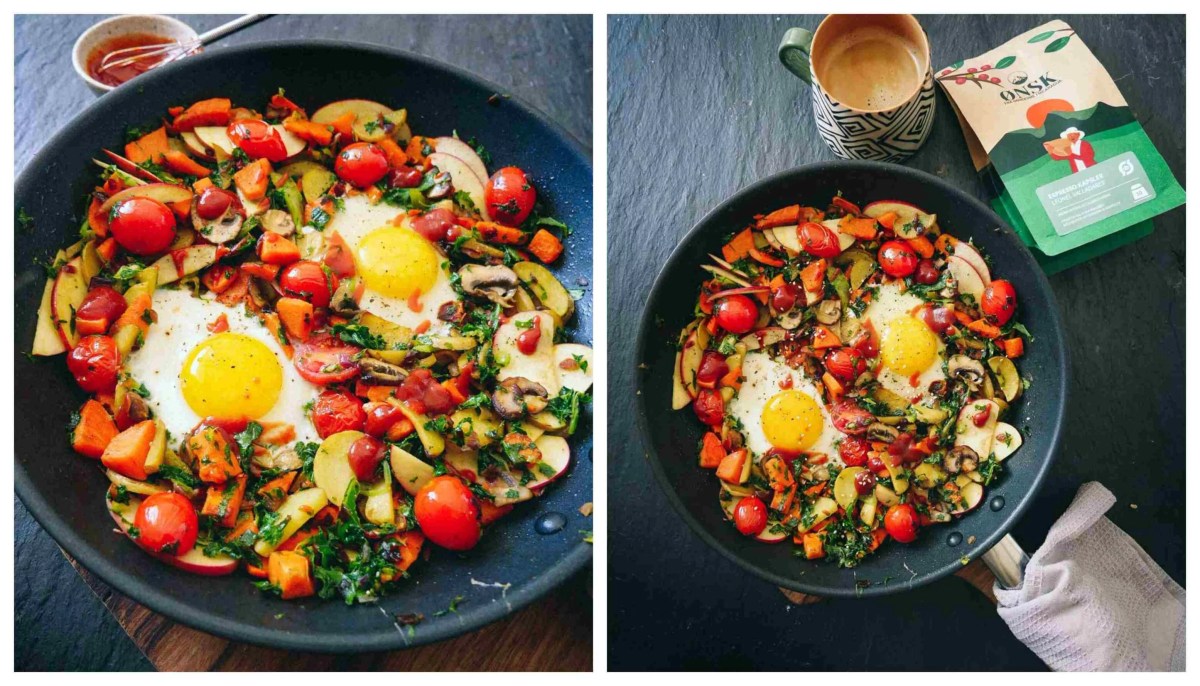Imagine vibrant plates bursting with color and flavor, each bite a symphony of textures and nutrients. This isn’t just breakfast; it’s a revitalizing experience, a delicious journey into the world of egg-centric flexitarian meals brimming with wholesome vegetables. We’ll explore creative recipes, showcasing the versatility of eggs as a protein powerhouse paired with the incredible variety and nutritional benefits of an array of vegetables. Prepare to elevate your morning routine with dishes that are both satisfying and incredibly healthy.
From Mediterranean-inspired frittatas to Asian-inspired veggie scrambles, we’ll delve into diverse flavor profiles and cooking techniques. Discover how to seamlessly incorporate seasonal produce, adapt recipes to suit various dietary needs, and unlock the secrets to creating breakfasts that are as visually appealing as they are nutritious. Get ready to transform your breakfast experience with these exciting and healthy recipes!
Step-by-Step Cooking Instructions

This section provides a detailed, step-by-step guide for preparing a delicious and nutritious egg and vegetable frittata. This recipe is easily adaptable to your preferred vegetables and dietary needs, making it a versatile and satisfying flexitarian breakfast option. The instructions below detail a stovetop method, followed by alternative oven-baked and air-fried variations.
Stovetop Frittata with Roasted Vegetables
- Preparation: Preheat and Chop. Preheat your oven to 400°F (200°C). Wash and chop your chosen vegetables. For this example, we’ll use 1 cup of chopped broccoli florets, ½ cup sliced bell peppers (any color), and ½ cup chopped red onion. Imagine a vibrant mix of green, red, and purple against a white cutting board, the vegetables glistening slightly from their recent wash.
- Roast the Vegetables: Toss the chopped vegetables with 1 tablespoon of olive oil, salt, and pepper. Spread them evenly on a baking sheet. Roast for 15-20 minutes, or until tender-crisp. The image shows the vegetables arranged neatly on the baking sheet, their colors intensified by the roasting process; the broccoli is a bright, vibrant green, the peppers a glossy red and yellow, and the onions a deep, caramelized purple.
- Whisk the Eggs: In a medium bowl, whisk together 6 large eggs with a splash of milk or cream (about 2 tablespoons), a pinch of salt, and pepper. The image depicts a wooden spoon vigorously whisking the eggs in a ceramic bowl until the mixture is light and frothy, with small bubbles visible on the surface.
- Sauté Optional Additions: (Optional) If you’d like to add some sautéed mushrooms or spinach, heat a tablespoon of olive oil in a non-stick skillet over medium heat. Sauté until softened, about 5 minutes. Imagine a sizzling pan with earthy-smelling mushrooms browning gently in the oil, their edges slightly crisp.
- Combine and Cook: Pour the egg mixture into the skillet. Evenly distribute the roasted vegetables and any sautéed additions over the eggs. Cook over medium-low heat for about 5-7 minutes, or until the edges are set and the bottom is lightly browned. The image displays the skillet, the eggs lightly browned around the edges, with the vibrant vegetables peeking through the creamy yellow egg mixture.
- Finish and Serve: Sprinkle with your favorite cheese (optional, e.g., cheddar, parmesan). Continue to cook for another 2-3 minutes, or until the eggs are fully cooked through but still slightly moist. The image shows the finished frittata, slightly puffed up, with a sprinkle of golden-brown cheese on top. It’s ready to be sliced and served.
Alternative Cooking Methods
This recipe can also be prepared using different cooking methods, each resulting in a slightly different texture and flavor profile.
Oven-Baked Frittata
The oven-baked method requires placing the egg mixture and vegetables in an oven-safe skillet and baking at 350°F (175°C) for 20-25 minutes, or until set. This method results in a fluffier, more evenly cooked frittata. The image shows a golden-brown frittata, cooked evenly throughout, sitting in an oven-safe skillet.
Air-Fried Frittata
For an air-fried version, spray a lightly oiled oven-safe skillet with cooking spray and arrange the vegetable and egg mixture. Air fry at 350°F (175°C) for 15-20 minutes, or until cooked through. This method results in a slightly crispier frittata. The image displays a slightly crispier, evenly browned frittata in an air fryer basket, with the edges exhibiting a delicate crispness.
Vegetable Spotlight
The versatility of vegetables in egg-centric breakfasts is truly remarkable, transforming simple eggs into vibrant and nutritious meals. From adding a simple crunch to creating complex flavor profiles, vegetables contribute significantly to both the taste and nutritional value of your breakfast. The possibilities are as endless as your imagination, allowing for a diverse range of culinary experiences, day after day.
The choice of vegetables significantly impacts the overall sensory experience of your egg-centric breakfast. Consider the contrasting textures: the satisfying crispness of bell peppers versus the tender softness of spinach; the juicy burst of tomatoes against the creamy richness of avocado. Similarly, the flavor profiles range from subtly sweet (like butternut squash) to intensely savory (like mushrooms). This variety allows for the creation of breakfasts that cater to a wide spectrum of palates and dietary preferences.
Nutritional Comparison of Common Breakfast Vegetables
Five vegetables frequently incorporated into breakfast dishes offer a compelling array of nutritional benefits. Understanding these differences allows for mindful selection based on individual dietary needs.
| Vegetable | Key Nutrients | Nutritional Benefits |
|---|---|---|
| Spinach | Vitamins A, C, K, folate, iron | Boosts immunity, supports bone health, improves blood health. A single cup of raw spinach provides more than 100% of the recommended daily intake of vitamin K. |
| Bell Peppers (especially red) | Vitamins A, C, potassium | Powerful antioxidant, supports eye health, aids in digestion. Red bell peppers contain significantly more vitamin C than green bell peppers. |
| Mushrooms | Selenium, Vitamin D, potassium, B vitamins | Supports immune function, contributes to bone health, acts as a natural source of vitamin D (especially when exposed to sunlight). |
| Avocado | Healthy fats, fiber, potassium | Promotes heart health, aids in digestion, provides sustained energy. Avocados are unique in their high content of monounsaturated fatty acids. |
| Tomatoes | Vitamin C, lycopene, potassium | Powerful antioxidant, supports skin health, protects against certain cancers. Lycopene, a carotenoid, is a potent antioxidant found in high concentrations in tomatoes. |
Flavor and Texture Impact of Vegetable Choices
The selection of vegetables directly influences the final flavor profile and textural elements of the dish. For instance, adding sautéed mushrooms and onions creates a savory depth, while incorporating roasted sweet potatoes contributes a natural sweetness and creamy texture. The contrasting textures of wilted spinach and crispy bacon bits add complexity and interest. The vibrant colors of colorful bell peppers not only enhance the visual appeal but also signal the presence of various vitamins and antioxidants. Consider the impact of a simple addition of fresh herbs, like chives or parsley, for a burst of fresh flavor and aroma.
Embarking on a flexitarian breakfast journey means embracing a world of culinary possibilities. These egg-centric recipes, packed with vibrant vegetables, offer a delightful balance of protein, fiber, and essential vitamins, setting the stage for a productive and energized day. Beyond the specific recipes, the key takeaway is the empowerment to experiment, adapt, and create your own unique breakfast masterpieces. So, explore the endless combinations of flavors and textures, and discover the joy of a healthy and delicious start to your day!
Questions and Answers
Can I prepare these breakfasts ahead of time?
Many of these recipes can be partially or fully prepared in advance. Frittatas, for example, can be made the night before and reheated. Consider what elements can be prepped (veggies chopped, etc.) to save time in the morning.
Are these recipes suitable for children?
Yes, with minor adjustments. You can finely chop or puree vegetables for younger children. Ensure you choose vegetables your children enjoy and consider offering a side of fruit for added sweetness and appeal.
What if I don’t like eggs?
While these recipes center around eggs, you can explore substitutions. Tofu scramble is a popular vegan alternative. Consider using beans or lentils as a protein source and adapting the recipes accordingly.
Where can I find seasonal vegetables?
Farmers’ markets are a great place to find seasonal vegetables at their peak freshness and flavor. Local grocery stores also often highlight seasonal produce.


